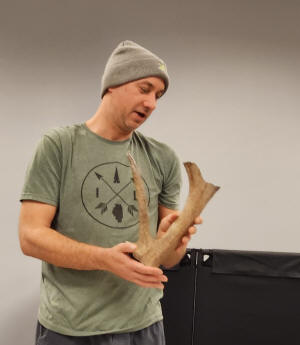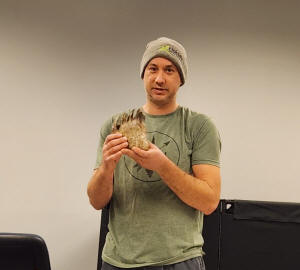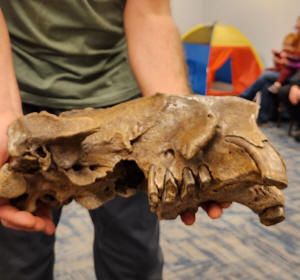|
 Waller
grew up in the country between Mason City and New Holland and has
always been interested in history. He has spent time exploring
creeks and has found fossils, coral, rocks, arrowheads and various
other artifacts that way. Waller also collects glass and bottles. Waller
grew up in the country between Mason City and New Holland and has
always been interested in history. He has spent time exploring
creeks and has found fossils, coral, rocks, arrowheads and various
other artifacts that way. Waller also collects glass and bottles.
While growing up, Waller said he felt everything had been discovered
and all the adventures were in the past. He now knows there is more
history to be discovered if you have the eye for it and look at your
surroundings. There is so much history right beneath our feet.
Waller’s uncle has a big collection of artifacts and Waller has
always been interested in Native American culture and artifacts. He
always wanted to find some.
As Waller kayaks with friends, he often looks for rocks on gravel
bars when they stop.
When children are on playgrounds, Waller said they can sometimes
find little artifacts, which some call Indian beads, in pea gravel.
He said finding these artifacts was his first introduction to
fossils.
The fossils give us a snapshot of the ancient sea floor. Waller said
around 20 million years ago the county was in an inland sea.

One time when he was younger, Waller was with a
friend who excitedly found an arrowhead. Waller looked and looked to
find one too.
When looking for beaver sticks to build for a fort for his son,
Waller finally found an artifact. From there, he began to collect
items like glass bottles and stones. He has now developed an eye for
such artifacts. Waller said it is like mushroom hunting because he
just keeps searching to find something.

Many artifacts Waller found were at ground level at
some point, then sediment washed over them. Waller said crinoids,
which are marine animals, were underwater then washed ashore.
After the 2021 flood in the county, Waller said some artifacts were
deposited on gravel bars. In August 2021, Waller found several
Native American artifacts.
In nearby Sugar Creek, Salt Creek and Kickapoo Creek, Waller said
chain corals from 20 million years ago can be found.
These artifacts have different levels of preservation. Some
artifacts have been in water for years, which breaks them apart.
Waller tries to find the artifacts and preserve them before they are
completely destroyed.
Most are found on the clay layer and redeposited when water washes
them out. Waller said other fossils may be found submerged or on a
gravel bar.
When the fossils are exposed to air, Waller said they degrade. To
help preserve fossils and other artifacts, Waller uses paleo bond,
which he compared to super glue. He drips the bond on and lets it
soak into the artifact. Within an hour, the artifact will become
solid.

The age of these fossils ranges from a few hundred
years to thousands and even millions of years. Millions of years
ago, Waller said there were oceans in this area.
During the ice age, when Waller said it was called the glacial
maximum, glaciers were at their tallest height after years of being
built up.
Waller said the earth started warming up 20,000 years ago, and the
glaciers began to recede. The earth started cooling again 10,000
years ago and glaciers began growing again.
Some think a meteor hit in Canada around 10,000 years ago and Waller
said it would have affected the glaciers. It also caused many
climate issues in North America.
All these changes put a strain on the megafauna, a name for large
animals. Waller said these changes wiped out nearly 90 percent of
big game animals. Even humans were struggling.

One interesting artifact Waller brought was elk
antlers. He said 200 years ago, elk were in Logan County.

On one exploration, Waller found a fully intact
mammoth molar. It was literally sitting on top of a sandbar and
Waller was in shock. He said it is unusual to find these teeth fully
intact with the roots.
Mammoths only survived on grasslands. Waller said they could eat
grass on the cold tundra. He described their teeth as being like
pestle mortars or two rocks grinding against one another. Mammoths
had around six molars throughout their lifetime. The belief is that
some mammoth starved to death because their teeth would wear out.
Around 12,000 years ago, the mammoths in North America died off. In
Siberia, Waller said they became extinct close to 10,000 years ago.
The blood of the mammoth was almost like antifreeze. Waller said
that helped them live in cold climates.
[to top of second column] |

Up north, Waller said people have found mammoths with
skin and tissue intact. Scientists are trying to use the DNA from
these mammoths to bring mammoths back.
Trees would push into the creek areas when the climate warmed up.
Waller said mastodons and ground sloths would then appear.
Mastodons had different teeth than mammoths. Waller said mastodons
could crush leaves with their teeth. He has mastodon teeth in his
collection though he did not bring any.

Another fossil Waller found turned out to be a giant
beaver femur, which was confirmed by the Illinois State Museum. He
said it was from a juvenile beaver that would have lived around
11,000 years ago.

Waller found the skull of a giant ground sloth, which
he initially thought might be a beaver. When he discovered it was a
ground sloth, Waller was shocked. He said the teeth of the sloth are
different from the teeth of a beaver. The sloth’s teeth look a bit
like tusks.
These ground sloths had massive claws and were around eight to ten
feet long. Waller said they were about the size of a Volkswagen
Beetle. These animals stripped the leaves off trees.
Ground sloth had the scientific name Megalonyx Jeffersonii. Waller
said they were first found out East. Thomas Jefferson thought the
bones were that of a lion. Jefferson did not believe animals could
become extinct and asked Lewis and Clark to find the lions. There
were cave lions running around at the same time as these sloths.
Years ago, Waller said animals would outgrow their predators due to
competition with the predators. If something big was coming after
you, Waller said you were likely to grow big claws.

Animals ebbed and flowed with nature cycles. Waller
said years ago, stag moose, which were exceptionally large, could be
found in this area.
Waller has even found bison bones, which shows they were once in
this area.
Though it is hard to find fossils further North, Waller said
glaciers deposited interesting rocks.
With some of the little fossils Waller has found, he has made
necklaces. Another artifact Waller found was a spear point used to
hunt mammoths.
Humans allegedly followed large game to the Americas. Waller
considers these big animals key to our journey to the Americas.
Humans would not likely have gotten here if it were not for the
mammoth herds and other megafauna.
To Waller, the large game was like Walmart walking
around because the humans could use their skin and bones for food,
clothing and even shelter. The herds moving was like having a new
Walmart pop up.
The first art is pictures of mammoths. Early crafts were made from
ivory. Waller said that shows there was interaction between humans
and these animals.

When the big animals died out, Waller believes it may
have been due to climate changes or super volcanoes. Animals can
adapt to incremental change, but Waller said they do not adapt well
to massive change. The characteristics that made the animals
successful in the area may no longer help them.
Humans need to remember how these changes can affect everything.
Waller asked people if they had questions and one person asked how
he preserves arrowheads.
If Waller finds arrowheads, he can usually just wash them with soap
and water and scrub them with a toothbrush since they do not
deteriorate much.
One person said people used to find arrowheads in the plowed farm
fields. With some of the no till farming methods that is less likely
to happen now.
Waller’s uncle used to find quite a bit in fields in the 1980s.
Waller agreed that it is harder to find these items in fields now.
Another person asked Waller how he documents artifacts he finds and
whether he notes where he found it.
When he finds something, Waller said he usually takes photos of what
he finds. He can usually pull up where he is on a map and take a
photo of the location to help document everything.
If the artifacts come from a certain area, Waller will often go back
and look for more in that area. He said finding many artifacts in
one spot shows there was a larger group of people living in that
area.
Towards the end of his presentation, Waller told everyone to keep an
open mind as they look for artifacts.
As Waller said, discoveries are just waiting to be found and these
discoveries can teach us more about our history.
[Angela Reiners]
|